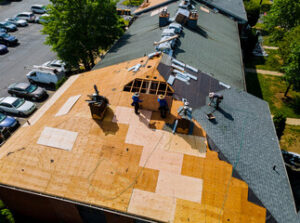Roofs are essential to a home and protect us from sun, wind, rain and snow. However, they are not indestructible and can sustain significant damage over time. When damaged beyond repair, it may be necessary to replace a roof. The most common Roof Replacement Erie PA options are re-roofing and tear-off. Both have pros and cons, depending on your home.
Cons

The main drawback of roof replacement is that it can be more costly up front than repair. However, it can also increase your home’s value and curb appeal and help prevent further damage to your house from pests such as termites and ants, rot from mold and raccoons. It is also important to consider your future plans for the house. If you are considering selling it in the near future, you might want to opt for a partial replacement and run new shingles up to a ridge or valley so that the comparison of old and new does not stand out as much.
Costs
A full roof replacement can cost a lot. However, the greatest cost is often not one line item, but rather the amount of time and energy a homeowner spends fighting an insurance company to get what they deserve. The good news is that newer roofs are considered less vulnerable and more able to stand up to harsh weather conditions, meaning they can qualify for a better value in a home insurance policy.
The type and cost of roofing materials you choose will also impact your costs. Asphalt shingles are popular for conventionally sloped roofs, while metal and cedar roofs are more durable options. Your roof’s slope and complexity will also impact which roofing types are compatible with it.
In addition to the cost of materials, you’ll also need to factor in local labor rates and fluctuating material prices. These factors will vary depending on your geographic location, but you can expect them to have a significant impact on your overall costs.
The number of square feet your home has also impacts how much a roof will cost. Square footage doesn’t just include living spaces, but can also factor in garages, porches, decks, and covered entryways. For this reason, it’s important to talk to your contractor before estimating the square footage of your home.
You’ll also need to factor in the cost of any building permits required for your project, if applicable. These will typically run anywhere between $300 and $1,500 for a residential permit in Brooklyn. In addition, if your property is in a historic district, additional steps and fees may apply.
Whether you decide to go with a partial or a complete replacement, the cost of your roof will still be significantly higher than the cost of repairing it. This is because repair work tends to reveal other issues with the structure, such as underlying damage, mold, and more.
Additionally, a partial replacement will save you some money on materials, but it won’t prevent the old sections from needing to be replaced in a few years, meaning you’ll end up paying even more for a roof that doesn’t last as long as it should.
Insurance
Insurance benefits can make the cost of a new roof much more manageable. Many homeowner’s policies cover damage caused by natural disasters or unforeseen incidents like fire or vandalism. However, these claims can be trickier than they might seem. Whether your claim is approved and how much money you receive from the insurance company depends on a lot of factors.
For example, the age of your roof is a major factor in whether you can get full replacement coverage or not. Insurance companies typically consider older roofs more susceptible to damage, so they may limit or exclude them entirely. On the other hand, a newer roof is more likely to be considered as having a higher value than an old one and may qualify for full replacement coverage.
Another major factor is your roof’s condition and upkeep. If you have a well-maintained roof that is free of pre-existing damage and regular inspections, insurance adjusters will likely view it favorably. This is because a well-maintained roof is less likely to be damaged by a natural disaster or unforeseen incident, so it will serve its purpose of protecting your home.
A well-maintained roof also shows that you care for your property, and that will be seen positively by your insurance company. This will also help you avoid unnecessary claims and increase your chances of getting the maximum amount of coverage available to you.
When you do file an insurance claim, it’s important to have an expert review your roof’s damage and repair estimates before you send them to your insurance company. This will ensure that the damages are accurately assessed and that you’re not being offered an insufficient amount of money to cover a new roof.
